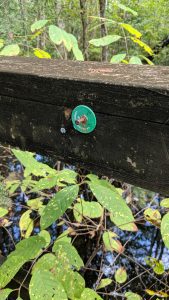
While attending the Public Land Acquisition and Management conference in St. Augustine, I was lucky to join the group on a quick visit to Julington-Durbin Creek Preserve.
Smack dab in between suburban townhomes and restaurant chains, this park is a hub for outdoor recreation, providing neighbors a natural escape from the hustle and bustle of Jacksonville. The 2,000-acre preserve straddles two creeks: Julington and Durbin. The sandhill ridge between the creeks rises above the shady, wet forests that line the dark waters. Longleaf pines, cabbage palms, and beautiful pink and yellow wildflowers blanket the property. Green fly orchids dazzle native plant lovers, and trails meander through the property.
Acquired with Amendment 1 monies in 2001, the park is co-managed by the St. Johns River Water Management District and the City of Jacksonville. Originally used as timberland, the WMD has successfully fallen much of the slash pine on the property, replacing it with hardier longleaf pine. Threatened by air potato and other invasives (including feral hogs), the property is managed with fire. Using fire is even more difficult in developed areas as managers must consider how smoke will affect nearby neighborhoods, schools, and hospitals, and they must take extra precautions to inform the community about the need for this essential management measure. Part of this education is ensuring accessibility throughout the burn process. What better way to experience land management than to see it in action – alongside management staff from the safety of the trail.
Julington-Durbin Creek Preserve is the diamond of suburban Jacksonville. Visitors come here to run in 5Ks, participate and volunteer in summer programs for at-risk youth, and see wildlife like white-tailed deer, turkey, and butterflies. Not only is it fun on a sunny day, but when storm clouds roll in and rains fall, the preserve is inexplicably valuable as a buffer between rising waters and nearby homes. During Hurricane Matthew in 2016, creek water levels rose significantly. If these lands hadn’t been preserved and were rather used for development, those potential landowners would have been in trouble. By protecting wetland areas and the uplands that border them, we plan for rainy days. These lands are incredibly valuable both ecologically and to the visitors that love them. Visit this little piece of natural Florida!





